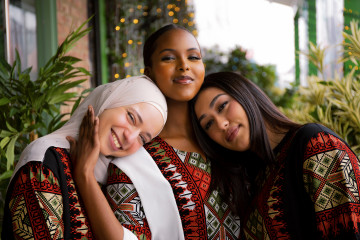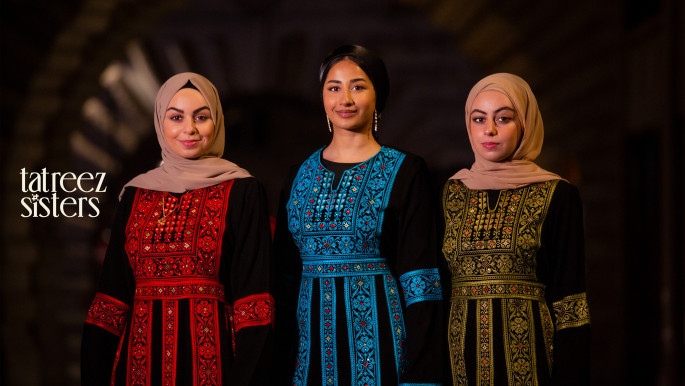

“Through this Tatreez project, I feel as though I am doing this to serve the Palestinian cause. How do I serve it? By preserving our cultural traditions, because Israel aims to erase Palestine and anything Palestinian from the world.”
As we mark the International Day of Tatreez and Palestinian Culture, the powerful words of Manar, a community organiser in the Shatila Refugee Camp, take us on a journey to understand how the needle became the tool of choice for Palestinian women in the face of colonial efforts to eradicate their existence.
Tatreez is an ancient style of embroidery that has been practised in Palestine for over 3,000 years. It holds great cultural significance for the Palestinians. We should be crystal clear, however, that Tatreez is more than just a fashion trend, and the items adorned with this needlework are much more than just dresses.
"The importance of Tatreez in Palestinian society has developed through time, with these gowns (known locally as thobes) becoming a symbol of resistance as well as a celebration of the land's rich history and culture"
My work has allowed me to become acquainted with the Palestinian cause. In May of last year, I went to the Shatila Refugee Camp in Beirut, Lebanon, with a group of friends. While there, I had the opportunity to meet with local community leaders, hear about the issues that the camp's residents confront, and explore ways to support their activities.
Their primary initiative was to establish a Tatreez centre to help unemployed women in the camp enhance their embroidery abilities while also providing them with a safe and inclusive social atmosphere. We were able to return later that year and construct a sustainable Tatreez centre for these women thanks to a successful fundraising drive.
The importance of Tatreez in Palestinian society has developed through time, with these gowns - locally known as thobes - becoming a symbol of resistance as well as a celebration of the land's rich history and culture.
A single image can communicate a thousand stories, but Tatreez embroidery's intricate patterns and interweaving of rainbow threads embody a thousand words of defiance.
Tatreez was originally used as a method of representation, with different designs representing different regions. These embroidered motifs graced thobes, which were worn at weddings, social gatherings, and ceremonies.
Tatreez, in addition to being a form of artistic expression, offers Palestinian women a sense of economic empowerment and independence. The talent for making garments and other sellable items provides women with the possibility to earn money. Women have played an important role in the Palestinian cause, and Tatreez has been a vital part of that effort.
Tatreez embroidery is an ageless art form, with seniors passing down their skills to younger generations of women to ensure the preservation of their cultural heritage. The act of a mother giving this expertise to her daughter was a wonderful and significant experience, as it symbolised their love and respect for their land, with Tatreez serving as the fabric's embodiment of this expression.
But how exactly did the nature of these garments change? I spoke with British-Palestinian campaigner Leanne Mohamad about the matter to obtain further understanding. According to Leanne, "When my grandparents, along with 750,000 other Palestinians, were expelled from their homeland in 1948, Palestinian women either wore their Tatreez thobes or carried them on their backs, as a statement of the very existence of the villages they were ethnically cleansed from."
The events of May 15, 1948, represented a watershed moment in both Palestinian and Tatreez history. In what’s known as "The Nakba" - the catastrophe in Arabic - Zionist forces ejected three-quarters of a million Palestinians from their ancestral homes, with the majority never being able to return. In the face of relocation and erasure, the needle evolved from a tool for artistic expression to a weapon of resistance and endurance.
|
Historically, the Israeli government has attempted to eradicate Palestinian culture by prohibiting, erasing, and destroying any symbols that depict the original people's culture and history. The Palestinian flag, in particular, has been outlawed and confiscated throughout the occupation.
During the First Intifada, from 1987 until 1993, the flag and its colours were banned, giving rise to the 'Intifada Dress,' Tatreez thobes embroidered with the flag, national colours, and resistance symbols. In these thobes, Palestinian women demonstrated their anti-colonial stance and undying defiance.
Regrettably, Israel's government continues to seize and destroy Palestinian symbols, including the Palestinian flag. Israel's security minister, Itamar Ben Gvir, banned the flying of Palestinian flags in public locations and ordered the removal of all visible flags in January 2023. Despite these efforts to obliterate Palestinian culture, women have stayed firm in their resistance, preserving their tradition and telling their tales through Tatreez and other kinds of art.
The rise of social media has created new pathways for international solidarity with the Palestinian people, as well as a new generation of young Palestinian women interested in their ancestors' work. Learning Tatreez is a way for these women to share their lived experiences via embroidery.
Leanne and her sister Lamar formed their online platform Tatreez Sisters in 2020, with the goal of preserving Palestinian culture and identity by showing their love for their ancestors and giving back to local communities in need. They donate 10% of all profits to Palestine International Medical Aid (PIMA). They have been able to reach a larger audience and share the beauty and significance of Tatreez with the rest of the globe thanks to their platform. I asked Leanne about her introduction to Tatreez and how that journey and experience unfolded for her.
“Growing up, we developed a huge passion for Tatreez, fuelled by our parents' and grandparents' guidance and teachings, which instilled in us a strong appreciation for our Palestinian identity, which encompassed our history, education, and culture. Since we were little, our grandmother would regularly gift us Tatreez thobes and accessories from back home. She would surprise us with a new set every time we outgrew them, strengthening our connection to this magnificent art form and our Palestinian history!” Leanne proudly states.
As British-Palestinian women growing up in the diaspora, Tatreez connected them to their roots and provided a reassuring reminder of home. Tatreez Sisters' significance extends beyond the sale of embroidered clothing. They realise the importance of Tatreez in preserving their heritage and providing a sense of home as British-Palestinian women who grew up in the diaspora.
Their aim has grown to include educating others about the art form and its significance to the Palestinian struggle. Their first short film, which introduces Tatreez and its importance in the anti-apartheid movement, has had over 700,000 views, demonstrating a strong demand for education and understanding Palestinian culture. The Tatreez Sisters' platform allows them to share the beauty of Palestinian needlework while also offering a venue for education and conversation.
|
“We want to show the world not just the wonderful beauty of Tatreez, but also why it is so important to Palestinian women as a form of resistance,” Leanne affirmed.
The inclusion of Tatreez on UNESCO's list of Intangible Cultural Heritage is a crucial step towards protecting and promoting this vital Palestinian art form. More may be done, however, to raise knowledge and appreciation for Tatreez outside of the Palestinian community. This could include putting on exhibitions, workshops, and other cultural activities to bring the art form to a wider audience. Additionally, educational programmes might be devised to incorporate Tatreez into the school curriculum and teach the talent to those who are interested.
The Tatreez Sisters have ambitious plans for the future. They're excited to keep growing their selection of amazing designs and items, and they're even considering launching their own pop-up shop or store in the centre of London. With their love of Palestinian culture and steadfast dedication to highlighting the beauty and significance of Tatreez, it's apparent that they have a bright future ahead of them.
Leanne, Lamar, Manar, and countless more Palestinian women who are sharing their culture and history with the world are doing incredible work. Their efforts to preserve and teach others about Tatreez are critical to the Palestinian people's continuous struggle for justice and self-determination.
According to Leanne, “Tatreez art embodies the threads of Palestinian identity that the world frequently attempts to ignore.” This rich cultural history, however, continues to thrive and expand because of the dedication and enthusiasm of these women. They are remembering their grandparents' legacies and guaranteeing future generations will never forget the significance of this magnificent art form through their work.
Saoud Khalaf is a British-born Iraqi filmmaker and writer based in London. His videos, which have garnered millions of views across social media, focus on social justice for marginalised groups with specific attention on the Middle East. His latest documentary premiered at the Southbank Centre for Refugee Week.
Follow him on Twitter: @saoudkhalaf_
![The fully functioning Shatila Refugee Camp women’s Tatreez workshop [photo credit: Saoud Khalaf]](/sites/default/files/styles/medium_16_9/public/2023-05/Workshop.jpg?h=0431bdac&itok=yxIH63LT)




 Follow the Middle East's top stories in English at The New Arab on Google News
Follow the Middle East's top stories in English at The New Arab on Google News


